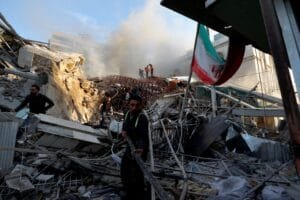In a shrinking, brackish pool of water, within earshot of Ukraine’s front lines, two small fish gasped and flopped in the midday heat.
Around them, vast expanses of mud and rock – covered, for the past three quarters of a century, by metres of water – were exposed to the sun. A huge grain barge lay sprawled across a nearby sandbank. Water snakes and frogs slithered through the dwindling shallows as if in search of shade.
Two weeks after a suspected Russian sabotage operation destroyed the dam that holds back the Dnipro River to form the giant Kakhovka reservoir, some 18 cubic kilometres of water – enough to fill a shallow paddling pool the size of England – have surged south to vanish into the Black Sea.
“It’s a catastrophe. Everything was washed away. Deer, wild pigs, fish and so many endangered species. And about half a million people are now left without water,” said Anatolii Derkach, 37, secretary of the town council in Marhanets, on the western shore of the former reservoir.
From his fourth-floor office, Derkach peered out across the grey, cracked mud towards the silhouette of Europe’s largest nuclear power plant on the eastern shore. The Zaporizhzhia plant, with its six reactors, is currently under Russian occupation. With the water gone, the plant – some 10km (six miles) away – suddenly looks much closer.
“They say it will have enough water in its reservoirs for about six months. But we cannot be sure,” he said with a sigh, followed by the inevitable warning-word “Chernobyl” – a reference to the nuclear power plant whose reactor exploded in 1986 in Soviet Ukraine, causing the worst nuclear accident ever.

Meanwhile Marhanets, a small town perched on a hill overlooking the reservoir, is often targeted by Russian artillery.
“They watch us with drones. If they see more than five people in one place they begin shelling,” said Derkach.
But with the reservoir emptying, and water supplies now cut off, the council has been obliged to set up temporary distribution points around town.
“How do you think I feel? I’m walking around like a donkey, forced to carry water,” said Iuliia, a pensioner standing in a queue of more than 20 people beside a set of taps and a large plastic tank in the town centre.
“It’s not even drinking water. I’m scared for the future. I don’t see any way through this,” said her neighbour, Nina, 70.
Marhanets, and other nearby towns, are drawing up plans to dig new canals to connect them to other reservoirs. But many residents have left, and local mines and other industries have been forced to close. Local farmers are now trying to access old wells and small streams to find alternative sources of water.
“I don’t know what [the Russians] were thinking – doing that. The environment will suffer, and it will be hard for all of us,” said Ivan Zaruski, 56, taking a brief break from loading bales of straw onto a trailer with a group of relatives and neighbours in field outside town.
“The main thing is that the nuclear power plant doesn’t explode. But we’ll survive all this. We have nowhere else to go so we don’t have a choice,” he added with a grin.
Moscow says it had nothing to do with the destruction of the Kakhovka dam in Russian-occupied territory, and has accused Ukraine of firing missiles at it.

Meanwhile, further south, below the destroyed dam, the heaving flood waters that swept, without warning, through the port city of Kherson and smaller towns killing dozens of people and forcing thousands to flee, have largely abated.
“We’re like rats – we can survive anything,” said Irina, a 73-year-old retired teacher, as she and her husband, Evhenii, slowly dragged the drenched contents of their small cottage outside.
At one point the flood waters reached the roof of their home, on Tchaikovsky Street, close to the Dnipro River in the centre of Kherson. But now only a few big puddles remained outside, beside several small boats which had been used during the flooding.
“At least this happened at the start of summer. We still have time to dry things out,” said Evhenii, stacking some stinking, rotting furniture in the yard.
Earlier that morning, several Russian artillery shells had crashed into the centre of Kherson, and many more would land in this neighbourhood in the coming hours and days, fired from Russian positions on the far bank. Ukrainian troops were blocking cars from getting too close to the river, and much of the city seemed deserted.
“Today was wonderful,” said Oksana, who’d come to help her elderly parents on Tchaikovsky Street clean up after the flood. She was referring to news about Ukraine’s counter-offensive.
“Our guys are doing a great job. We can tell who is shooting where. Our guys have had some big successes against Russian positions – and they’ve hit some large ammunition depots. I just wish it was all happening a bit quicker,” she said.
Nearby, her 78-year-old father, Vladimir, slumped into a chair. He’d been kneeling, with an axe, to strip water-logged sections off an old cabinet, but had stood up too fast.
“He was born here. He’s spent his whole life here. Most of the people who’ve stayed in this neighbourhood are elderly. They’re not going anywhere,” said Oksana.

Source : BBC

















Add Comment